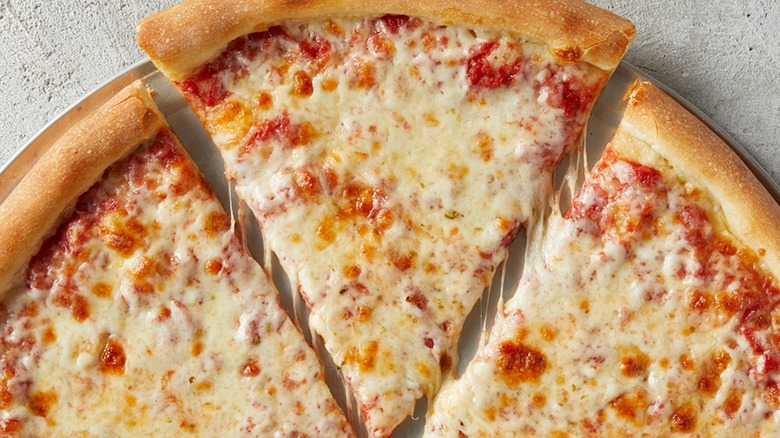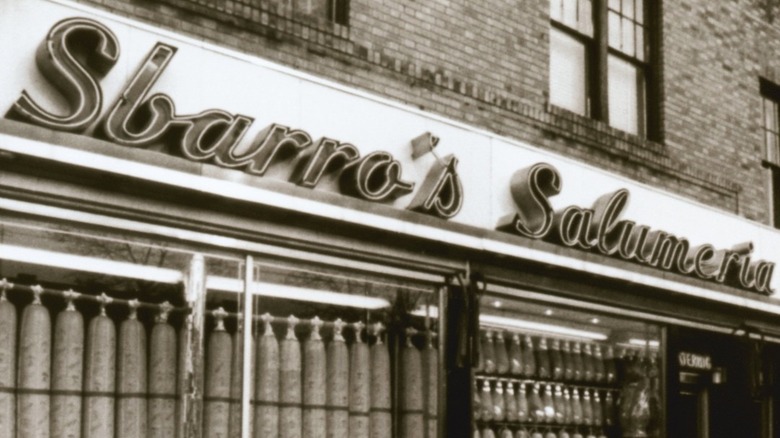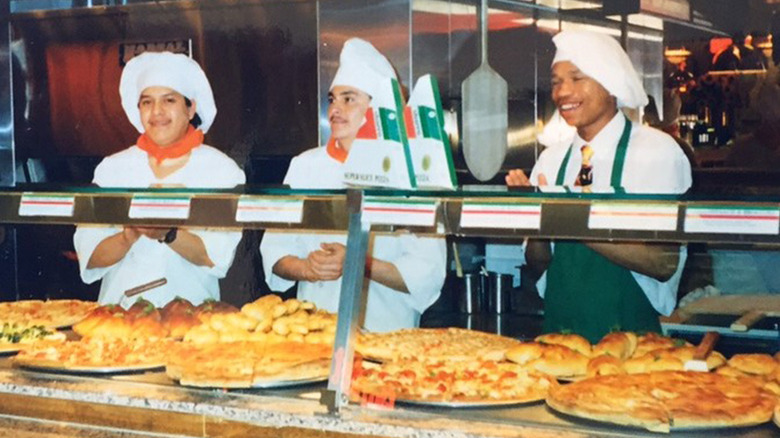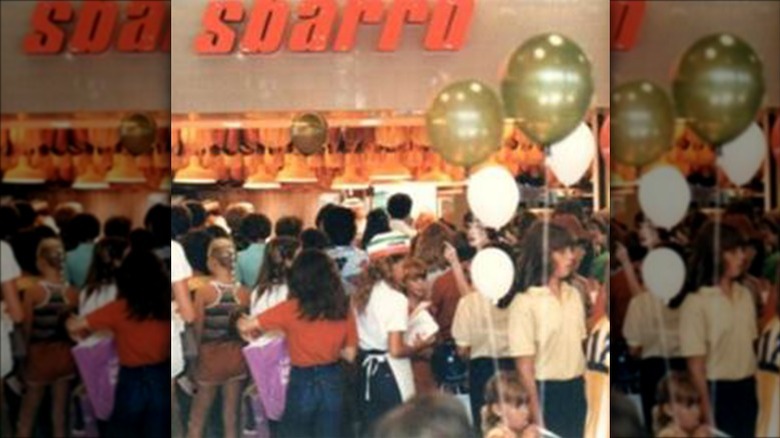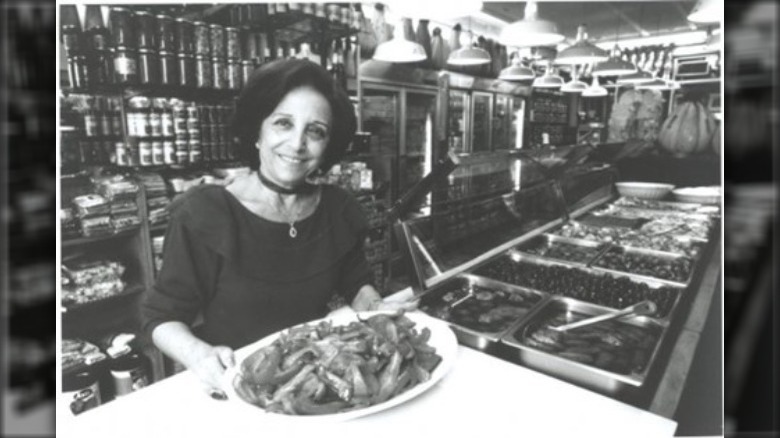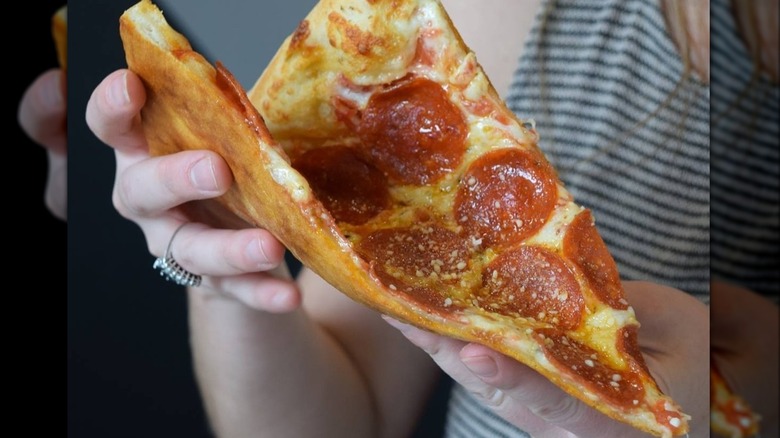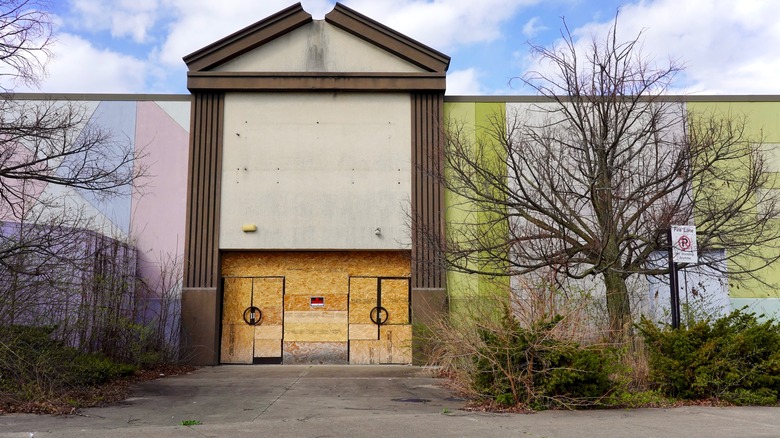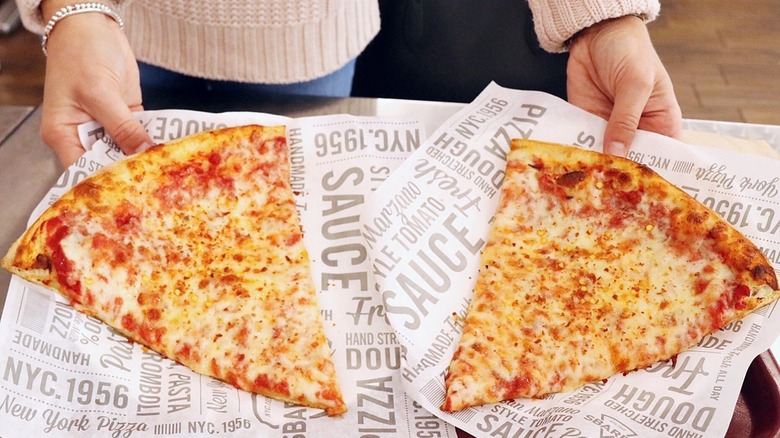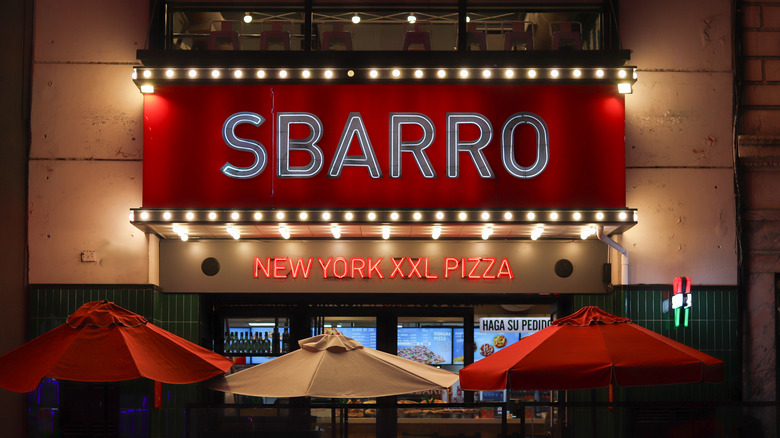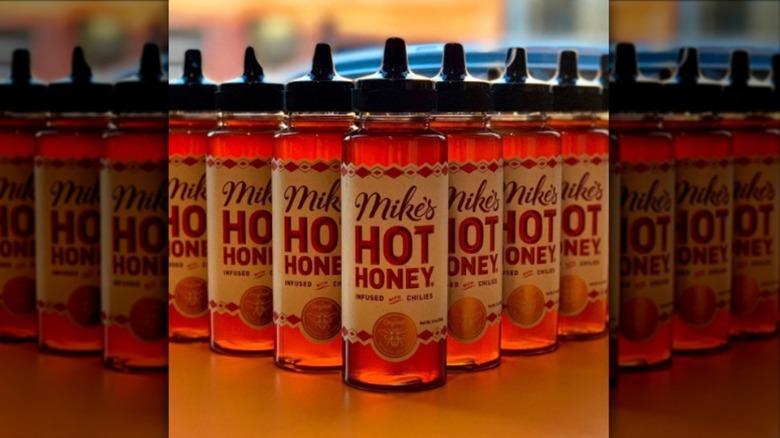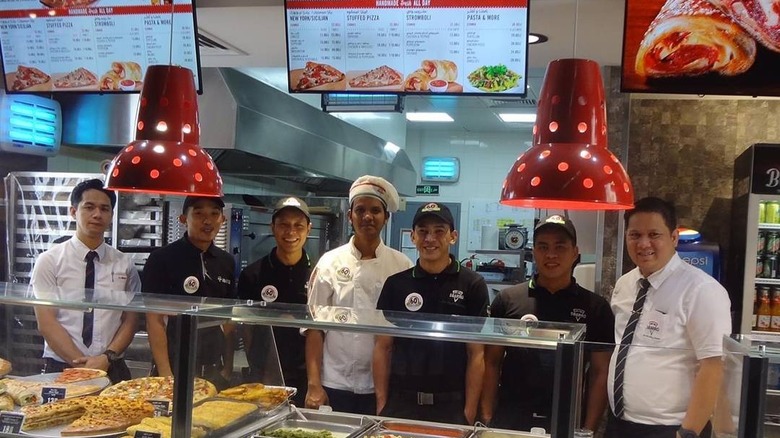The Rise And Fall And Resurgence Of Sbarro
If you are of a certain age, you most likely equate an oversized slice of Sbarro pizza with a trip to the mall. Regardless of your opinion on the quality of the pizza, you probably hold some level of nostalgia for the giant, cheesy slice. Sbarro has been a staple of food courts across America since the '70s. You may be surprised to learn the story of Sbarro begins way before the New York-style pizza slice became an iconic fixture in mall food courts everywhere. Sbarro has its beginnings in a Brooklyn neighborhood when a married couple from Naples, Italy, opened an Italian salumeria. The story of Sbarro begins with Carmela "Mama" Sbarro selling slices of pizza to passersby and making cheesecake in her Bensonhurst restaurant kitchen.
Sbarro positioned itself at just the right time in mall food courts — right before malls exploded upon the American culture. But when Amazon and online shopping took over, Sbarro struggled. The following story is one of meager beginnings leading to dramatic success followed by a fall. But can Sbarro shift its focus from a mall-centric fast food pizza joint to something else? Let's take a look at how it all played out for the famous fast food pizza from Brooklyn.
Sbarro's Story Begins in Brooklyn in 1956
If you've ever grabbed a slice of Sbarro pizza from the food court in the mall, you probably had no idea of the authentic Italian beginnings of the chain. In 1956, Gennaro and Carmela Sbarro opened the first Sbarro in the neighborhood of Bensonhurst in Brooklyn, New York. The first Sbarro wasn't strictly a pizza joint, but an Italian grocery store named Sbarro's Salumeria. The Sbarros had recently immigrated from Naples, Italy. Carmela, (known as Mama Sbarro) handed out slices of pizza to workers passing by the store. The pizza was in such demand that the family opened a second location in the 1960s, this one dedicated to selling pizza. Even as the company grew, Mama Sbarro continued making pizza and helping customers in the original location until she retired and the shop closed in 2004. The loss of Sbarro's Salumeria changed the neighborhood and disappointed many loyal customers.
An article published in The New York Times after Mama Sbarro's death, described her as a woman who knew her way around the kitchen and held employees to high standards. A nearby shop owner recalls, "She was military almost ... a little, tiny, petite thing." She held her customers to the same high standards, refusing to add mayonnaise or ketchup to sandwiches. The deli was known for its traditionally smoked mozzarella and high-quality meats and cheeses. It's clear to see that Sbarro would not be what it is today without Mama Sbarro and her Salumeria.
The First Mall Sbarro Opened in 1970
Today, Sbarro is synonymous with mall food courts, and it all began in 1970 when the company opened a store in Kings Plaza Shopping Center in Brooklyn. This would be the first of many mall locations and is still open today. Modern shopping malls began cropping up in the suburbs sometime after World War II when cars were abundant and department stores were booming. Malls became more than places to shop, but were cultural centers and gathering grounds for teens. The early malls did not have elaborate food courts, but instead offered quick snacks, like ice cream and soft pretzels. The Sbarro family had a different strategy. Previously operating as a deli, restaurant, and catering business, the company saw an opportunity to get its product to a growing market.
The family wanted to offer restaurant quality food to busy shoppers. Anthony Sbarro, son of Gennaro and Carmela, told PMQ Magazine, "We had a concept that we believed would get them to stop and walk in and grab a bite." The food was displayed behind plexiglass so shoppers could see what was offered. Originally, Sbarro kept a tight control over their product. In the early years, everything was made in the original location in Bensonhurst, including the cheesecakes. Not only were the cheesecakes made in-house, they were all made by Mama Sbarro. That is until demand grew for 1,000 cheesecakes a week and her son Joseph had to convince her to let their supplier take over.
The 1980s and '90s: Sbarro Went Public and Could Be Found in Food Court Malls Across the Country
The Sbarro strategy to sell pizza by the slice to mall shoppers resulted in resounding success. People all across the country, from the Midwest to the South to the West Coast, could get a taste of authentic New York-style pizza, or at least as close to New York-style pizza as they had ever seen. Sbarro opened the company to franchising in 1977 and went public in 1985. Before going public, Sbarro had 97 stores. Only a few years later, Sbarro expanded to include 220 locations (63 of those were franchised units.) Not only that, people in Canada and Puerto Rico could now get a slice of Sbarro's New York-style pizza. And the company continued to expand. During the late 1980s, Sbarro was opening around 70 restaurants per year. In 1990, the first Sbarro in Europe opened in England. By the mid-90's, Sbarro had grown to 729 locations.
Grabbing a slice of pizza from Sbarro was a popular activity for mall shoppers in the '80s and '90s and people today remember the heyday of the mall food court with nostalgia. As a Reddit user commented, "Missing those days after a long day of shopping, you go down to the mall food court and have a slice of delicious Sbarro cheese pizza." While another Redditor said, "Back around 1990 the local mall Sbarro was the busiest corner of the food court."
In 1999, the Family Bought Sbarro Back for $400 Million
By the late 1990s, the Sbarro family seemingly regretted their decision to take the company public in 1985. In 1999, the family bought shares of their company from public shareholders, turning the company once again into a private family-owned affair. The deal, at $28.85 per share, cost the Sbarros $389.5 million total. However, according to the Restaurant Finance Monitor, purchasing the shares resulted in the company acquiring a lot of debt. It took three tries for the family to obtain 100% of the shares from investors. Two prior attempts had failed. With the Sbarro family once again at the helm, Sbarro continued expansion, with 800 restaurants in 1999 and over 900 by 2001.
In 2004, Mama Sbarro retired and the original Sbarro's Salumeria closed in Bensonhurst. This year was also considered the peak of Sbarro, with sales reaching $465 million that year. However, the Sbarro business model of positioning itself in malls would be its ultimate downfall. Jerry Sbarro, the grandson of Carmela and Gennaro, told The New York Times in an interview in 1995, "Our traditional marketplace is shopping malls. Shopping malls are a captive-audience market, where we are the No. 1 player. No one competes with us in a shopping mall, no one." But by 2007, the traditional indoor mall was no longer the bustling center it had once been.
In 2007, the Sbarro Sons Sold the Company Again
Did the Sbarro family see the writing on the wall for malls and subsequently, the troubled future for Sbarro? In 2007, Gennaro and Carmela's sons were running Sbarro and decided to sell Sbarro to a private equity firm. The deal with MidOcean Partners was for $450 million and included a new management team and a new CEO, Nicholas McGrane. At the time of the sale, Sbarro had 1,000 stores in 34 countries and managed 11,000 employees. Locations were mainly in malls, airports, casinos, and universities.
In 2009, just two years after the sale, Moody's added Sbarro Inc. to its "Bottom Rung" list. On the list are companies Moody's predicted were the most at risk for defaulting on loans and were also facing limited cash flow. America was in the middle of the Great Recession, the period from 2007 to 2009 when consumer spending was down and more people were eating at home. Food court restaurants in malls were struggling, and so was Sbarro. 2008 saw a peak number of retail bankruptcies at 441.
The Recession, the Decline of Malls and Sbarro's Massive Debt
Although the Great Recession was officially over in June 2009, retail and dining-out establishments did not bounce back as quickly. The term "retail apocalypse" was used to describe the loss of sales from physical brick-and-mortar stores to the online behemoth, Amazon. Amazon began as an online bookseller, but by 1998, the company was selling more than books. By 2005, Amazon launched its Prime service and shoppers began turning to online shopping rather than heading to the mall. With shoppers staying home, food courts sat empty.
In 2011, Sbarro was drowning in debt. Perhaps if mall traffic had rebounded to its earlier levels, Sbarro could have reversed its debt issues. But with online shopping resulting in less mall traffic, Sbarro could not keep its head above water. The company's debt was $487 million and assets only came to $471 million. The debt was too much and Sbarro declared bankruptcy in April 2011.
Inflation Drove up the Cost of Cheese, Flour, and Real Estate
The hardship of less mall traffic was not the only problem Sbarro had to face. Dave Bagley, who was a principal at financial turnaround firm MorrisAnderson, told QSR Magazine that the inflated cost of rent in malls contributed to Sbarro's financial woes. "If you look at what real estate costs were and construction costs in that 2005–2008 time period, they were extremely inflated," Bagley said. Sbarro was located in malls that were, "based on continued growth, and as we know now, some of those things didn't come to fruition," explained Bagley.
Real estate costs were high, but so were the prices of corn, cheese, and flour. Food inflation began in 2010, with worldwide prices up 25% in just one year. Sbarro struggled to make ends meet with high rent, soaring food costs, and fewer sales. The debt was too much to overcome, leading Sbarro to declare bankruptcy in April 2011. This, however, would not be the end for Sbarro. By filing bankruptcy and restructuring, the company was able to reduce its debt by over half the amount. By the end of the year, Sbarro was in much better shape with less debt and a cash infusion of $35 million from lenders.
Sbarro Shifts Its Strategy With a Rebranding
Bankruptcy gave Sbarro a second chance, offering a cash infusion, less debt, and a new strategy. Driving its new business strategy was a new CEO. In February 2012, management changed and Jim Greco took over as president and CEO. Greco was no stranger to bringing companies back from near collapse. Under his leadership, the national bagel chain, Bruegger's Bagels, went from stagnant sales to a growth rate of 20% per year from 2004 to 2008. After his stint at Bruegger's, Sbarro hired Greco to make some much-needed changes. Today, Greco is known as a "turnaround veteran" and is currently the CEO of Tijuana Flats, guiding it through its restructuring.
In an article written by Greco in 2017 for Nation's Restaurant News, the CEO laid out his method for helping a struggling business get back on its feet. "Start short-term. Though a full turnaround can take years, start with a 90-day plan," Greco said. While Greco only stayed at Sbarro for a year, he provided them with a vision and future strategy. In the next several years, Sbarro worked at revamping recipes, training management on improving hiring and teamwork skills, and listening to customer feedback. A few years after Greco's departure, Sbarro announced a company rebranding and updated menu. The Chief Marketing Officer at the time, Anne Pritz, said in a statement, "We've gone back to our roots with laser focus on what we are famous for -– XL New York style pizza made fresh daily with high-quality ingredients."
Sbarro Begins Opening Off-Mall Sites and Venturing Into Delivery
Sbarro's efforts at a turnaround included remodeling some locations while closing unprofitable ones. With a focus away from a larger menu of the '90s, Sbarro streamlined its offerings, returning to its roots — the large slice of New York-style pizza that Mama Sbarro used to sell to workers in the 1950s. Other changes the company made were venturing into locations that weren't inside malls and launching a delivery service. In 2016, when other pizza joints were offering convenient online and mobile app ordering, Sbarro was just figuring things out. Today, however, customers can easily order a full pizza, plus other menu offerings, online or from an app from Sbarro and have it delivered directly to their door.
Once again looking for places where crowds of hungry people congregate, Sbarro began opening locations inside convenience stores in 2022. Sbarro's current CEO, David Karam, told QSR Magazine, "We knew that there was a limited development potential in the mall venues, and that's where we started to push harder into convenience stores and travel centers, casinos, and colleges and places where there was high foot traffic, and thank God it's worked." Opening these locations also makes delivery an easier job than Sbarro pizza delivery drivers had in the past, navigating through a mall parking lot, and making their way to the food court.
Mike's Hot Honey Teams Up with Sbarro for a Hot and Sweet Italian Fusion
A successful trend for restaurants and food companies has been to partner up with each other in brand collaborations in the hopes of increasing brand awareness and innovating recipes. Beginning in 2021, Sbarro began offering the popular New York-based Mike's Hot Honey as a dipping sauce served alongside its pizzas, breadsticks, and strombolis. Mike's Hot Honey is infused with chili peppers, and the company has had collaborations with other well-known brands including Club Crackers, Moe's Southwest Grill, and Utz Pretzels.
Mike's Hot Honey used to only be found in pizzerias in Brooklyn. The brand took off in 2010 when founder, Michael Kurtz, was an employee of Brooklyn's Paulie Gee's Pizzeria. Kurtz was inspired by a trip to Brazil when he tasted pizza drizzled with chili-infused honey. He began drizzling pizzas with his spicy honey concoction, and customers loved it. Before long, people were asking to buy the hot honey by the bottle. The rest is history, and Mike's Hot Honey is now found nationwide.
In Only Two Years, Sbarro Has Opened 200 Restaurants
Sbarro's latest business strategies seem to be working. From its early beginnings in Bensonhurst to mall locations across America and the decline of the American mall, it has once again reinvented itself. With its focus on delivery and opening stores in bustling locations beyond the mall, Sbarro has been growing. In the last couple of years, the company has opened 200 new stores reaching over 700 locations around the globe. It has been expanding into new markets nationwide including countries such as Columbia, Poland, and Denmark. Though it can still be found in malls and airports, Sbarro is now in places it had not entered before such as convenience stores, casinos, military bases, hospitals, and universities.
Sbarro may have just positioned itself in the next big American growth trend, similar to its move to enter malls in the '70s. Convenience stores are on the rise with over 150,000 of them currently operating in the U.S. In the past two years, the amount of convenience stores has increased at a rate of 1.5% per year. People are looking for more than just chips and soda when they enter a convenience store. These stores are offering a higher quality level of on-the-go meals and ready-to-eat food than in the past. Sbarro is in the perfect position to jump on the trend.
